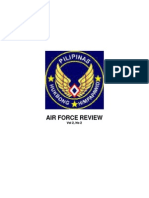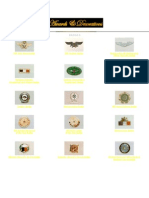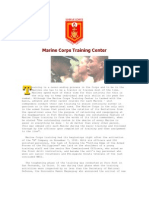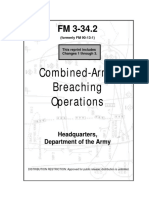Philippine Air Force - PAF Standards
Philippine Air Force - PAF Standards
Uploaded by
jb2ookwormCopyright:
Available Formats
Philippine Air Force - PAF Standards
Philippine Air Force - PAF Standards
Uploaded by
jb2ookwormCopyright
Available Formats
Share this document
Did you find this document useful?
Is this content inappropriate?
Copyright:
Available Formats
Philippine Air Force - PAF Standards
Philippine Air Force - PAF Standards
Uploaded by
jb2ookwormCopyright:
Available Formats
Symbols
PHILIPPINE AIR Blue Background Circle - Represents the official color of
FORCE the Air Force being the guardian of the Philippine skies.
OFFICIAL SEAL
Three Yellow Stars - Represents the three (3) major
islands of the Philippines, namely Luzon, Visayas, and
Mindanao which the Philippine Air Force is sworn to
defend and protect.
Golden Wing - As gold is a precious metal, rust proof and
with lasting luster, it symbolizes everlasting patience and
deep sense of commitment by brave airmen who love to
reach the infinite skies to attain their goal. The wing is
similar to the original Philippine Air Force seal adopted in
1947 to represent the flying profession.
Diamond of Three Colors - Representing the primary
The PAF Official
colors – red, white and blue of the Philippine flag to which
Seal was adopted
the Philippine Air Force has pledged its allegiance.
effective July 14,
1999. The usual
English inscription Yellow Inner and Outer Bands - Symbolizes unity and
of the Philippine Air quest for perfection.
Force was changed
to corresponding Pilipinas Hukbong Himpapawid - Proportionally
Pilipino words - distributed and divided by the three (3) stars around the
PILIPINAS wing, denotes the distinctive identification of the Philippine
HUKBONG Air Force as a major service of the Armed Forces of the
HIMPAPAWID. Philippines.
PHILIPPINE AIR FORCE
SONG
Lyrics by:
Captain Lauro Ll Abaño
Music by:
Lt Colonel Antonio
Buenaventura
Play
PHILIPPINE AIR FORCE
HYMN
Lyrics and Music by:
LTC SAMUEL O
SARMIENTO
Extracted from the
52nd Air Force Anniversary
Souvenir Program
History of the Roundel
PHILIPPINE AIR 1936-1941
FORCE
AIRCRAFT 1LT Basilio B Fernando made the first design. It was
ROUNDEL applied on Stearman 73L-3 primary trainer plane number
36-2, the first aircraft of the Philippine Army Air Corps to
take to the air. The aircraft was test-flown by 1Lt William
Lee over Zablan field on 2 May 1936, ushering the rebirth
of military aviation in the country.
Fernando's design was simple blue diamond framed by a
white lozenge. There were no borders; the contrast of
color was all that separated the inner and outer diamond
even as it outlined the whole design against the
camouflaged paint scheme of the PAAC aircraft. This
With the outbreak of
insignia was applied on aircraft rudder and on four wing
insurgency and
stations (upper and lower).
secessionist
movements, the
Philippine Air Force Fernando's design immortalized the genesis of aviation in
repainted even fixed the Philippines, for its diamond configuration was derived
wing aircraft from the insignia of the Signal Corps, the first military arm
involved in counter in the islands to experiment in flying aircraft. The insignia
insurgency thus covered the history of military aviation all the way
operations to back to the pioneering days of 1LT Frank P Lahm Jr.
camouflages and/or
fatigue. The Air 1946-1947
Force Roundel is
outlined in black on Following the end of World War II, a modified design was
these aircraft. evolved by the reconstructed Philippine Army Air Corps.
Still retaining Fernando's basic design, a blue border was
added to frame the outer side of the white lozenge. The
words "Phil Army" which was carried in the lower wings of
the pre-war aircraft was now deleted.
1947-1948
Following the elevation of the Philippine Army Air Corps
into a major command and component of the Armed
Forces on 1 July 1947, it was renamed and restructured
as the Philippine Air Force. The PAF subsequently
adopted a new insignia designed by Lt Tomas C Tirona.
Tirona retained the modified diamond of the post-war
period but he added white bars framed in blue outline on
both sides as stylized wings. This design was design was
applied on the wings and Starting 1969 With the outbreak
of insurgency and secessionist movements, the Philippine
Air Force repainted even fixed wing aircraft involved in
counter insurgency operations to camouflages and/or
fatigue. The Air Force insignia is outlined in black on
these aircraft across the vertical tail surfaces of the C-47
Gooney Birds.
1949-present
In 1949, the Philippine Air Force discarded the
camouflaged paint scheme and adopted silver as the
official color of all its aircraft. It also adopted a new logo.
The bars in Tirona's design were reshaped into layered
wings. The outer border of the white lozenge was now
also colored red. The national tri-color thus became
enshrined in the PAF's aircraft insignia.
In 1969, the Air Force received its first orders of UH-1H
helicopters. Fatigue and camouflage became the official
color of the helicopters. The roundel was replaced with
shade of black on all PAF aircraft involved in counter-
insurgency operations.
(Research data courtesy of Capt. Alberto Anido)
PHILIPPINE AIR FORCE Symbols
PILOT GOLD WINGS
The monkey-eating eagle - A distinctive Philippine bird
of prey, symbolizes the flying profession.
The equilateral triangle symbolizes liberty, equality and
fraternity.
The three stars represent the three main island
groupings of Luzon, Visayas and Mindanao.
Silver Wings
The gold sun with the Tagalog "K" symbolizes the birth
of freedom (K for Kalayaan), precious as the gold of which
Without star and it is made. The nine rays represent the first eight
laurel - Basic Pilot provinces, which revolted against Spain, and the Muslim
With star - Senior provinces, which heretofore had resisted the presence of
Pilot foreign invaders. (Except for the sun, the rest of the
With star and laurel badge is actually made of silver.)
- Command Pilot
Metal background within the equilateral triangle:
White - represented in plain surface of the upper portions
symbolizes purity.
Red - represented in horizontally lined surface on the left
portion symbolizes courage.
Blue - represented in vertically lined surface on the right
portion symbolizes peace.
The lone star, when present in the badge, indicates a
senior pilot rating.
The sampaguita laurel, when added to the star,
indicates a command pilot rating.
You might also like
- Philippine Army Manual 1 Basic Doctrine (2009)Document51 pagesPhilippine Army Manual 1 Basic Doctrine (2009)A.V. Jamorabo100% (2)
- Philippine Air Force - PAF OrganizationDocument40 pagesPhilippine Air Force - PAF Organizationjb2ookworm78% (9)
- Soldier of Fortune, Vol. 19, No. 12, December 1994Document86 pagesSoldier of Fortune, Vol. 19, No. 12, December 1994Regular Bookshelf100% (3)
- A Model For Diversification - Ansoff - 1958Document24 pagesA Model For Diversification - Ansoff - 1958SebastianCaballeroNo ratings yet
- Philippine Air ForceDocument11 pagesPhilippine Air Forcejb2ookworm100% (4)
- The Philippine Air ForceDocument6 pagesThe Philippine Air ForcegerwinryanrabayaNo ratings yet
- Pam 1-15 - OespaDocument374 pagesPam 1-15 - OespaCyrus James Silvestre100% (3)
- Philippine Navy - Philippine Fleet HistoryDocument9 pagesPhilippine Navy - Philippine Fleet Historyjb2ookworm100% (1)
- PafproppDocument34 pagesPafproppmayz088No ratings yet
- PROMEX Reviewer For A1C-SgtDocument42 pagesPROMEX Reviewer For A1C-Sgtjadestopa50% (2)
- Afp Awards and DecorationsDocument3 pagesAfp Awards and Decorationsnkmiplaal100% (1)
- Philippine Military Rank Insignia: General OfficersDocument4 pagesPhilippine Military Rank Insignia: General Officersfrancis_asd200389% (9)
- Morale and Welfare Updates 2017 Lecture To SMC July 2017 FinalDocument26 pagesMorale and Welfare Updates 2017 Lecture To SMC July 2017 Finaledgar gumpad67% (3)
- Military Discipline and CourtesyDocument13 pagesMilitary Discipline and Courtesyhumanupgrade100% (6)
- Philippine Navy Islands of Good Governance Revalida ReportDocument80 pagesPhilippine Navy Islands of Good Governance Revalida ReportPhilippine Navy Center for Naval Leadership & Excellence100% (3)
- Cadet Info File SummaryDocument11 pagesCadet Info File SummarySetherina SethNo ratings yet
- The Fighting Israeli Air Force PDFDocument230 pagesThe Fighting Israeli Air Force PDFmohammed100% (1)
- RAF Trainers Vol 1 1918-1945Document75 pagesRAF Trainers Vol 1 1918-1945Mike Costello100% (10)
- Republic Act 7077 - AFP Reservist Act of 1991Document17 pagesRepublic Act 7077 - AFP Reservist Act of 1991jb2ookworm100% (21)
- 1983: DoomsdayDocument20 pages1983: Doomsdayjb2ookworm100% (4)
- Air Force Review - Vol. 2, No. 2aDocument29 pagesAir Force Review - Vol. 2, No. 2ajb2ookworm100% (4)
- Four Major Command of Armed Forces of The PhilippinesDocument13 pagesFour Major Command of Armed Forces of The PhilippinesMeagan Manibo100% (1)
- Ra 9993 Coast GuardDocument11 pagesRa 9993 Coast GuardGillian Caye Geniza BrionesNo ratings yet
- Military Customs and TraditionDocument19 pagesMilitary Customs and TraditionCatherine NicolasNo ratings yet
- Air Force Review - Vol. 2, No. 3Document45 pagesAir Force Review - Vol. 2, No. 3jb2ookworm100% (4)
- PAF Flight Plan 2028 Hand OutsDocument18 pagesPAF Flight Plan 2028 Hand OutsArtRuszellHensonCastro100% (1)
- Air Force Review - Vol. 1, No. 3Document34 pagesAir Force Review - Vol. 1, No. 3jb2ookworm100% (3)
- Airforce TactiesDocument61 pagesAirforce TactiesNur Setsu50% (2)
- 3afp OrganizationDocument9 pages3afp Organizationmiztah_jkvNo ratings yet
- AFP HistoryDocument3 pagesAFP HistoryKimberly Nicole FactonNo ratings yet
- Military OrganizationDocument5 pagesMilitary Organizationhumanupgrade100% (8)
- Philippine Air Force - BadgesDocument1 pagePhilippine Air Force - Badgesjb2ookworm75% (4)
- Paf InitiationDocument41 pagesPaf InitiationAir Force SMO100% (1)
- Cir 30Document13 pagesCir 30Anonymous 1lYUUy5TNo ratings yet
- Military Courtesy and Discipline Ms1Document15 pagesMilitary Courtesy and Discipline Ms1genesisrevelations100% (1)
- Mil Courtesy & Discipiline-1Document29 pagesMil Courtesy & Discipiline-1OCIG AFPETDC100% (1)
- FC 8 043 Pa Drills and CeremoniesDocument140 pagesFC 8 043 Pa Drills and CeremoniesCarlo B Cagampang100% (1)
- SKT ReviewerDocument23 pagesSKT ReviewerEngelMerlDeVillaNo ratings yet
- Promex Reviewer For TSGT-MSGTDocument64 pagesPromex Reviewer For TSGT-MSGTairawaine91% (22)
- 5 - Manuscript For Emcee (Raati)Document4 pages5 - Manuscript For Emcee (Raati)Ramon Muscat100% (1)
- Military Organization1Document54 pagesMilitary Organization1Reniel De GuzmanNo ratings yet
- Functions Armed Forces of The PhilippinesDocument5 pagesFunctions Armed Forces of The PhilippinesSyril Mae Montejo GelaNo ratings yet
- Faq For Ojt SKTDocument31 pagesFaq For Ojt SKTKenneth DerequitoNo ratings yet
- Officer Manual For AspirantsDocument15 pagesOfficer Manual For AspirantsRowy John Divinaflor100% (3)
- Paf Ep Promotion: OLD NEW Grade Tenure in Grade (Years)Document7 pagesPaf Ep Promotion: OLD NEW Grade Tenure in Grade (Years)Rufhyne DeeNo ratings yet
- AFP History OrganizationDocument5 pagesAFP History OrganizationAna Lei Za ErtsivelNo ratings yet
- Military OrientationDocument22 pagesMilitary OrientationJarvie JohnNo ratings yet
- Afp Organization FinalDocument33 pagesAfp Organization FinalDanna GaileNo ratings yet
- Armed Forces of The Philippines Core Values: (Rank, Name, SN, Mos, Bos)Document23 pagesArmed Forces of The Philippines Core Values: (Rank, Name, SN, Mos, Bos)Christian Hernandez100% (1)
- Military Courtesy Discipline HODocument7 pagesMilitary Courtesy Discipline HONoGameNoLife Th11No ratings yet
- Afp Core Values & Code of EthicsDocument24 pagesAfp Core Values & Code of EthicsMarkrobert Magsino100% (5)
- Rotc Module 1ST SemDocument61 pagesRotc Module 1ST SemLowela Joy AndarzaNo ratings yet
- History of PNP.Document15 pagesHistory of PNP.Jorge Tessie ZamoraNo ratings yet
- 01 Legal Basis of ROTC Program PDFDocument8 pages01 Legal Basis of ROTC Program PDFXyza Faye Regalado100% (1)
- Afp Code of Ethics Jo AnnDocument60 pagesAfp Code of Ethics Jo Annjadefjrd12100% (2)
- Republic Act 7077 Afp Reservist ActDocument18 pagesRepublic Act 7077 Afp Reservist ActSicat Mark BantiyanNo ratings yet
- AFP TreeDocument2 pagesAFP TreeJayme Hora Abrina100% (3)
- Afp OrganizationDocument7 pagesAfp OrganizationArchie French100% (1)
- 5 - Reservist and Retiree AffairsDocument38 pages5 - Reservist and Retiree AffairsAlexs Villaflores100% (1)
- Colours and MarkingsDocument3 pagesColours and MarkingsMauri MrmNo ratings yet
- Acp NotesDocument6 pagesAcp NotesAaronNo ratings yet
- Third Generation Soviet Space Systems - Multi-Echelon Antiballistic Missile System - PolyusDocument6 pagesThird Generation Soviet Space Systems - Multi-Echelon Antiballistic Missile System - Polyusjb2ookworm100% (1)
- Soviet Military Power 1984 - Theater ForcesDocument18 pagesSoviet Military Power 1984 - Theater Forcesjb2ookworm100% (3)
- Soviet Military Power 1989 - Nuclear Strategic Defense and Space ProgramsDocument17 pagesSoviet Military Power 1989 - Nuclear Strategic Defense and Space Programsjb2ookworm100% (2)
- Soviet Military Power 1987 - Forces For Nuclear AttackDocument15 pagesSoviet Military Power 1987 - Forces For Nuclear Attackjb2ookworm100% (1)
- Soviet Military Power 1984 - Forces For Global WarfareDocument22 pagesSoviet Military Power 1984 - Forces For Global Warfarejb2ookworm100% (1)
- Divisions of World War IIDocument41 pagesDivisions of World War IIjb2ookworm100% (7)
- Third Generation Soviet Space Systems - Multi-Echelon Antiballistic Missile System - MKBSDocument7 pagesThird Generation Soviet Space Systems - Multi-Echelon Antiballistic Missile System - MKBSjb2ookworm100% (1)
- The Downfall of MarcosDocument8 pagesThe Downfall of Marcosjb2ookworm100% (4)
- Air Force Review - Vol. 2, No. 3Document45 pagesAir Force Review - Vol. 2, No. 3jb2ookworm100% (4)
- REPUBLIC ACT NO. 9372 - Human Security Act of 2007Document27 pagesREPUBLIC ACT NO. 9372 - Human Security Act of 2007jb2ookworm100% (5)
- Philippine Marine Corps - Combat Service & Support Brigade (The Field Artillery Battalion)Document3 pagesPhilippine Marine Corps - Combat Service & Support Brigade (The Field Artillery Battalion)jb2ookworm100% (1)
- Mutual Defense Treaty Between The United States of America and The Republic of The PhilippinesDocument2 pagesMutual Defense Treaty Between The United States of America and The Republic of The Philippinesjb2ookworm100% (1)
- Air Force Review - Vol. 1, No. 1Document41 pagesAir Force Review - Vol. 1, No. 1jb2ookworm100% (1)
- Air Force Review - Vol. 2, No. 2bDocument41 pagesAir Force Review - Vol. 2, No. 2bjb2ookworm100% (5)
- Air Force Review - Vol. 2, No. 1Document39 pagesAir Force Review - Vol. 2, No. 1jb2ookworm100% (3)
- Philippine Marine Corps - 4th Marine Brigade (Reserve)Document2 pagesPhilippine Marine Corps - 4th Marine Brigade (Reserve)jb2ookworm100% (1)
- Philippine Marine Corps - Vision of The Philippine Marine Corps ModernizationDocument10 pagesPhilippine Marine Corps - Vision of The Philippine Marine Corps Modernizationjb2ookworm100% (1)
- Air Force Review - Vol. 1, No. 3Document34 pagesAir Force Review - Vol. 1, No. 3jb2ookworm100% (3)
- Philippine Marine Corps - Drum & Bugle TeamDocument2 pagesPhilippine Marine Corps - Drum & Bugle Teamjb2ookworm100% (2)
- Philippine Marine Corps - Marine Corps Training CenterDocument3 pagesPhilippine Marine Corps - Marine Corps Training Centerjb2ookworm100% (6)
- Philippine Marine Corps - The Marine Security & Escort GroupDocument3 pagesPhilippine Marine Corps - The Marine Security & Escort Groupjb2ookworm100% (1)
- Philippine Marine Corps - HistoryDocument13 pagesPhilippine Marine Corps - Historyjb2ookworm100% (3)
- Philippine Marine Corps - Force Recon BattalionDocument3 pagesPhilippine Marine Corps - Force Recon Battalionjb2ookworm100% (1)
- AliensDocument266 pagesAliensJosh Belmore88% (8)
- Learning Milestones by Grade LevelDocument10 pagesLearning Milestones by Grade LevelTiffany MarinkovicNo ratings yet
- Landscape With A Blur ofDocument994 pagesLandscape With A Blur ofgdv82No ratings yet
- Armed ConflictDocument9 pagesArmed ConflictEd PalmerNo ratings yet
- Full Download Lonely Planet France PDF DOCXDocument62 pagesFull Download Lonely Planet France PDF DOCXazoofziyada100% (1)
- Naval Survivability and Susceptbility Reduction Study Surface Ship - NPS KokDocument138 pagesNaval Survivability and Susceptbility Reduction Study Surface Ship - NPS KokengmeccesarNo ratings yet
- The Cuban MissileDocument36 pagesThe Cuban MissileManuel Alejandro Roa RomeroNo ratings yet
- Thompson, William, The Soviet Union Under BrezhnevDocument199 pagesThompson, William, The Soviet Union Under BrezhnevDjuma Prezime100% (1)
- Helen of Troy Script Partial DraftDocument38 pagesHelen of Troy Script Partial DraftSam Reyes100% (3)
- 43-The Jugurthine War, 112-105Document3 pages43-The Jugurthine War, 112-105AC16No ratings yet
- Imagining The 1456 Siege of Belgrade in CapystranusDocument285 pagesImagining The 1456 Siege of Belgrade in CapystranusKatarina LibertasNo ratings yet
- Shadowrun Quick-Start Rules (Free RPG Day 2012)Document37 pagesShadowrun Quick-Start Rules (Free RPG Day 2012)Benjamin Cox100% (1)
- Cümle TamamlamakjkjDocument17 pagesCümle TamamlamakjkjFurkan KasaNo ratings yet
- Backgrounder - China's Naval Modernization and Implications For The United StatesDocument12 pagesBackgrounder - China's Naval Modernization and Implications For The United Statesopekoz100% (1)
- ECX Non-Coffee Pre-Trade Information Soybean Jan 9, 2024Document10 pagesECX Non-Coffee Pre-Trade Information Soybean Jan 9, 2024gedionb4No ratings yet
- Itwhy It Happened and How People All Over The World Were CopingDocument7 pagesItwhy It Happened and How People All Over The World Were Copingdporte19No ratings yet
- Nawfi - Fighter GenasiDocument3 pagesNawfi - Fighter GenasiLakosNo ratings yet
- Paper 32Document18 pagesPaper 32Jeya Balan AlagaratnamNo ratings yet
- Boston Massacre AssignmentDocument9 pagesBoston Massacre AssignmentJohn Brendel100% (1)
- Modern Indian History Cronology of EventsDocument11 pagesModern Indian History Cronology of EventsAshish AnandNo ratings yet
- Center City MapDocument1 pageCenter City MapAmisha GautamNo ratings yet
- AARules 1c PDFDocument16 pagesAARules 1c PDFOscar evilcore666No ratings yet
- Kovacs - Some Notes On The Divison of Illyricum PDFDocument11 pagesKovacs - Some Notes On The Divison of Illyricum PDFMirza Hasan CemanNo ratings yet
- Crim II ReviewerDocument10 pagesCrim II ReviewerDennis Aran Tupaz AbrilNo ratings yet
- (PDF Download) Apress Pro Oracle Database 18c Administration 3rd Edition Wei Zhi Fulll ChapterDocument34 pages(PDF Download) Apress Pro Oracle Database 18c Administration 3rd Edition Wei Zhi Fulll Chapterdimpozbnayan100% (6)
- Sword CatalogDocument10 pagesSword Catalogwill_d_mcfarland100% (1)
- Lost Love and Other Stories: Teacher's NotesDocument3 pagesLost Love and Other Stories: Teacher's NotesAmmar YasirNo ratings yet
- FM 3-34.2 Combined Arms Breaching OperationsDocument149 pagesFM 3-34.2 Combined Arms Breaching OperationsOperations PrimusNo ratings yet
















































































































